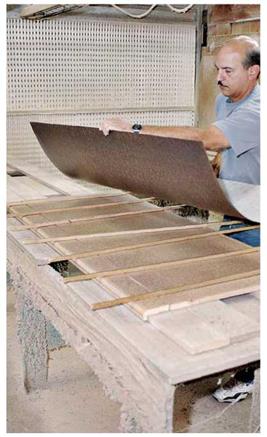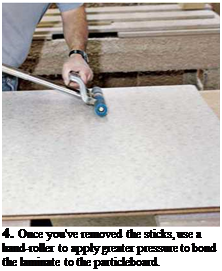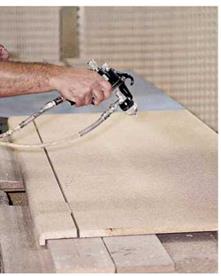ADHERING LAMINATE YOURSELF
|
|
|
|
|
|



irregular tile surfaces can be tricky to seal around sinks and splashbacks, so water can seep in and damage wood substrates.
Stone slabs include granite, marble, soapstone, limestone, and slate. Stone is naturally beautiful, but it’s also heavy, hard to work, and very expensive. Yet for all its heft, stone is relatively fragile and must be supported by a substrate—usually 14-in. plywood. Granite, the most popular stone, is available in slabs % in. and 1 !4 in. thick, up to 5 ft. wide and 10 ft. long. But because of its great weight, granite is usually installed in several sections 6 ft. long or less. Section seams are filled with a caulk that’s color-matched to the granite, so seams are virtually invisible. To create a thicker edge, fabricators epoxy two layers of stone. When pattern matched and polished correctly, the seams are almost invisible. Harder stones such as granite are highly scratch resistant. Softer stones, such as soapstone, can be scratched, but their softness allows you to easily sand out scratches or buff them out with steel wool. Stone is generally water resistant, though most stones are somewhat porous and so will stain unless protected. Penetrating sealants such as Aqua Mix Stone Sealer’s Choice® and Miracle Sealant’s 511 Porous Plus™ are well regarded in
the stone trade. For more recommendations, visit www. stoneworld. com.
Because stone is a natural material with inherent flaws and irregularities, few installers offer a warranty once an installation is complete. In the trade, it’s called "a tail-light warranty”; in other words, once the installer’s truck leaves your driveway, the warranty expires.
Concrete has become tres chic as a countertop material because it’s tough, reasonably priced, and highly malleable. It can be stained and polished to look like exotic stone, factory-cast with colorful glass shards in the bottom of its mold. Or it can be cast directly atop a base cabinet.
Concrete weighs roughly the same as stone. However, because a concrete slab needs to be fully 1 /2 in. thick, you need to overbuild base cabinets to support the additional weight. (Stone tops need to be 1h-in. thick only along their front edge.) Because the bottom of in-place form molds can sag between supports until the concrete sets, it’s smart to add cross-counter webs to support the forms. Concrete is notorious for cracking and staining, but you can minimize those problems by reinforcing the slab adequately with steel or poly fibers and finishing the surface meticulously.
Concrete gurus praise Berylex®, an admixture that strengthens and internally waterproofs slabs







Leave a reply